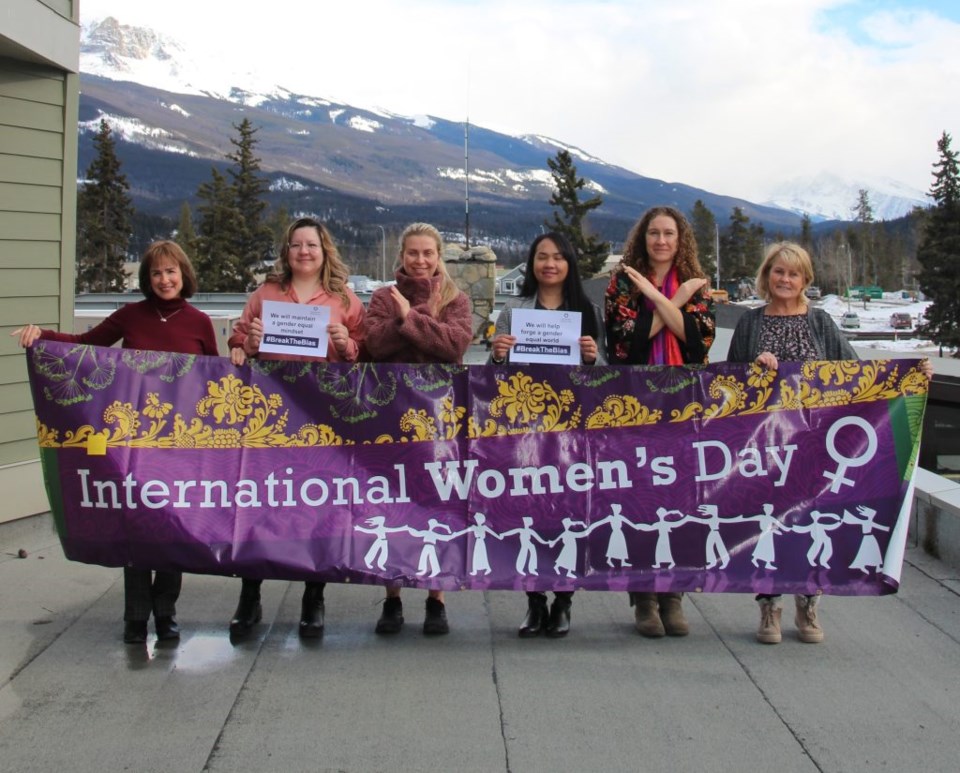
Joanne McQuarrie, Local Journalism Initiative Reporter | [email protected]
International Women’s Day challenged everyone to “Break the Bias” on March 8 by recognizing the achievements of women and recognizing gender equality.
Ginette Marcoux, executive director of the Jasper Employment & Education Centre, said in an email that women make up 49.5 per cent of the global population, and while progress has been made in gender equality over the last century, women and girls across the world are still left behind in political, economic and social terms.
“According to organizations such as the United Nations and UNESCO, more than two-thirds of the world’s 796 million illiterate people are women,” Marcoux said.
“It is estimated that 60 per cent of chronically hungry people are women and around 130 million girls are out of school worldwide. There is still much work to be done.”
Marcoux pointed out bias, whether conscious or unconscious, makes it difficult for women to move ahead and achieve equality.
“Unconscious gender bias is defined as unintentional and automatic mental associations based on gender, stemming from traditions, norms, values, culture and/or experience,” she said.
“Common gender gaps include both career advancement and pay, as well as gaps in hiring and opportunities for mentoring and professional development.
“There is no ‘one size fits all’ solution for unconscious gender bias. However, awareness training for HR professionals and managers, and an analysis of ratio of women-to-men in a company and the organizational levels they are employed in is a great starting point in identifying if unconscious bias exists in your workplace.”
Marcoux said with existing workforce shortages and struggles to attract and retain staff across Canada, businesses will benefit from ensuring that their workplaces are diverse, inclusive and equitable.
She highlighted a new report published by RBC Economics, which shows women in Canada have more than regained the jobs they lost early in the pandemic, but they still face pay and career imbalances, especially in key child-rearing years.
“The report said that after plummeting to a three-decade low at the onset of the crisis, the labour participation rate for women rebounded just as sharply and has soared to a record of 84 per cent in 2021,” Marcoux said.
She added that while these gains are encouraging, there are still some women who are not back to where they were pre-pandemic.
“As we pursue our post-pandemic recovery, closing pay and career gaps presents an extraordinary economic opportunity,” she said.
“RBC Economics writes, ‘If women’s wages were equal to men’s in comparable jobs, we could see an $18 billion boost to Canadian household incomes, an increase of 1.5 per cent.’”
That’s a positive projection, but Marcoux said, “A return to business as usual won’t be enough to get us there. Even as Ottawa’s affordable childcare policy is making its mark across the country, there is still work to be done in other areas to support women.”
That includes more opportunities for women for upskilling, the recruitment of more women into skilled trades and building pathways for women into senior roles, she said.
Marcoux said Canada also needs to build more parity between maternity and paternity leave.
“Currently women face a ‘baby penalty’ when maternity leave is taken and experience a 48 per cent drop in earnings in the year following the birth while men experience no penalty at all. If we can focus our attention on these solutions, the pandemic could be a turning point for women.”
International Women’s Day is symbolized by three colours—purple, green and white, which originated from the Women’s Social and Political Union in the United Kingdom in 1908, the original union of the suffragettes.
“Purple is the royal colour; it stands for the royal blood that flows in the veins of every suffragette, the instinct of freedom and dignity,” Marcoux said.
“White stands for purity in private and public life. Green is the colour of hope and the emblem of spring.”
This year, women across the world are being asked to strike the International Women’s Day 2022 pose, arms formed in a cross in front of face, and to share the picture on social media to encourage people to commit to helping women achieve equality.
“Feminist Gloria Steinhem, once said, ‘The story of women’s struggle for equality belongs to no single feminist, nor to any one organization, but to the collective efforts of all who care about human rights,’” Marcoux said.
“The Jasper Employment and Education Centre believes that we have a role to play in raising issues that create awareness and affect women’s abilities to participate equitably in the workforce in our community.”



